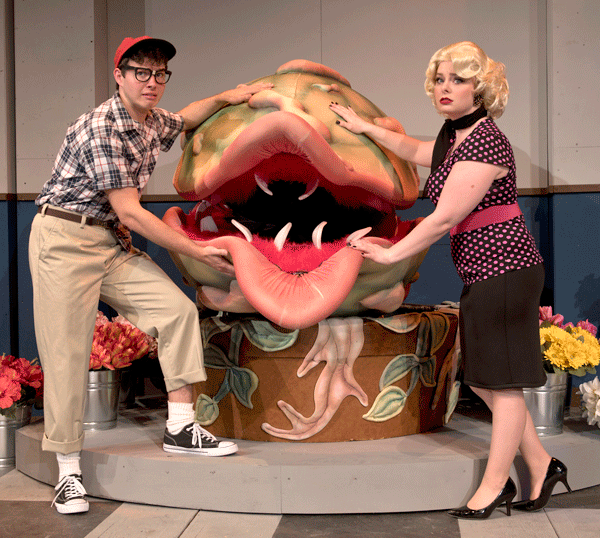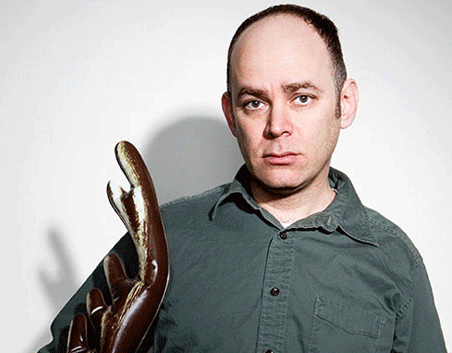For many years the most popular and often performed musicals followed a fairly predictable pattern. The stories and songs of musical theater greats like Rodgers and Hammerstein or Lerner and Lowe told sweet, sometimes dramatic, sometimes comedic, but always engaging stories of love. Unlikely love, turbulent love, innocent love – they ran the gamut. But almost always the stories ended romantically, with the boy winning the girl’s heart and everyone living happily ever after. There were a few classics along the way that ended less happily, with shows like The King & I and Carousel ending in death. But for decades the formula to Broadway musical success was to feature a winning couple audiences could love and root for.
Little Shop of Horrors isn’t exactly that musical.
At its center is a story of boy loving a girl, that’s true. But the path to that love is unique to say the least, and the end is out of the ordinary, way, way out of the ordinary.
The music reflects a clearly different approach than those of the 40s and 50s, instead exploiting the 1970s popularity of rock musicals and tapping into early rock genres like doo-wop and merging it with the smooth sounds of Motown. It is an unusual story wrapped in an unusual soundtrack.
Although the two men who wrote the music for Little Shop of Horrors weren’t as high profile when the show debuted in 1982, within the next 10 years Alan Menken and Howard Ashman were Oscar winners, well-known for providing the music for Disney classics The Little Mermaid and Beauty and the Beast.
For those unfamiliar with the show or the cult classic film which starred Rick Moranis, the perfect opportunity to catch up comes thanks to the IPFW Department of Theatre. With their season-ending production this month, department chair and Little Shop of Horrors director Beverly Redman brings this challenging musical to life at IPFW’s Williams Theatre, but she says the idea to do the show did not originate with her.
“Actually our students brought this title to us,” she says. “I try not to just think about what we’d all like to direct personally so that the students have some say in what we do. While it’s not a great literary work, there is a Faustian bargain at the center of the story where little Seymour wants the girl and wants to be loved.”
Of course Seymour has another significant relationship in his life, with his flesh-eating plant Audrey II taking up a bit of his attention. See, you won’t find that kind of twist in Oklahoma. The plant is a major player in the show (proof of that is that the voice of Audrey II in the 1986 film was Levi Stubbs of the Four Tops), and that piece of the production puzzle is no small element to staging the musical at a university theatre.
“The show is hugely challenging,” says Redman. “The space in our theater is not naturally suited to the number of sets in the show, so we had to find ways to have scenes that take place outside Seymour’s shop.”
In addition there’s the matter of accommodating the plant. After fed, Audrey II continues to grow, as plants are wont to do. Making that happen without a fly gallery has required some nifty tricks in set and lighting design. While Redman is reluctant to share too many secrets, thereby giving away some of the plot and production surprises, she does credit the staff and students of her department and the young performer who is acting as puppeteer and helping Audrey II come to life.
“One of our students, Cameron Tolliver, is our puppeteer for the show, and since we’re renting the plants, he’s had to work in rehearsals just mimicking the actions that he’ll be doing with the plant. The plant will be stalking people on stage, so he has to mimic that without the plant until we bring in the plants for the performances.
“One of our faculty, Kate Black, is also a personal trainer and has been working with Cameron because the person in the plant has to be strong. It takes a lot of upper body strength and core strength to do it, and he’s been working hard to get ready for all of that.”
One reason students appealed to the faculty to produce this particular play was the diversity of characters and roles available, and the puppeteer is just one unique aspect to the play. The quirkiness of the story cannot be denied either, and it represents a departure from plays earlier this season at IPFW.
Next year’s schedule is already set and also runs the gamut, allowing for the department’s students to get a full range of acting experience. The 2017-18 season will open with Frankenstein: An Act of Creation, followed by Jane Austen’s Pride and Prejudice, the musical I Love You, You’re Perfect, Now Change and Shakespeare’s Romeo and Juliet. The latter will be directed by Redman, and while it’s still a work in progress, she may set the classic story in a contemporary setting with a somewhat different conflict at its heart.
Although directing a Shakespearean tragedy is fairly traditional, the last year has been less so for Redman who not only directs IPFW’s production of Little Shop of Horrors this month, but also directed last summer’s production of The Rocky Horror Show at the Civic. Such offbeat stories have become crowd pleasers over the years, and Redman is hoping Little Shop of Horrors is going to be as interesting to audiences as it was to the students who asked to stage it.
“We generally open our shows on a Friday,” she says. “But we’re opening this one on Thursday, April 20 and have added some shows because we think this show will be of interest to people.”





